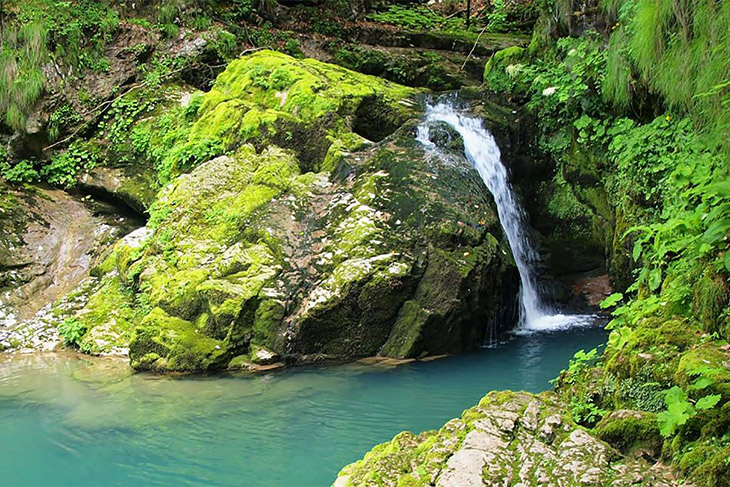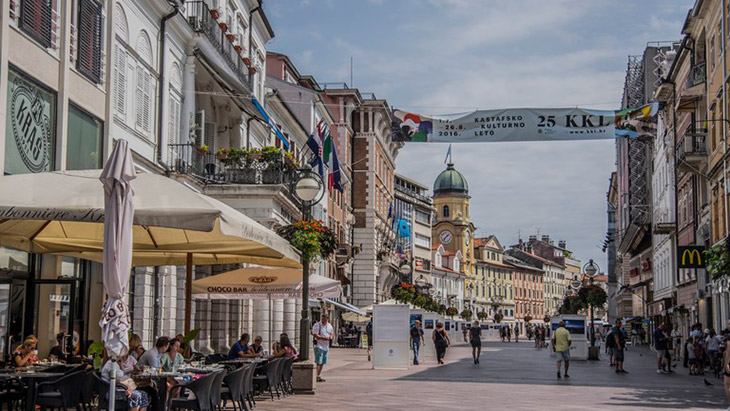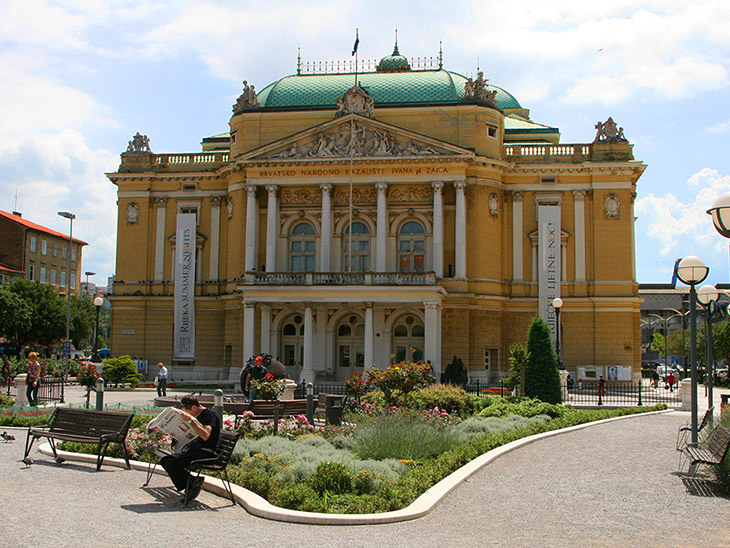Things to do & places to visit in Rijeka Croatia
Published: February 2nd, 2015
Author: Mate I
Located on Kvarner Bay, Rijeka is Croatian third largest city after Zagreb and Split.
It mainly acts as an administrative and cultural center of the Primorsko-Goranski county and it does not have a stereotypical Croatian resort identity because of the deep-water large sea port that serves as the biggest transport hub in Croatia.
Rijeka, Croatia is starting to turn towards tourism and services industry ever since the war in the 90’s caused sudden drop in sea traffic.

Regardless, people who pass through Rijeka will discover its unique cultural and natural beauties, charming nightlife, fun festivals and colorful carnivals.
The center is dotted with often overlooked beautiful buildings from the late Austro-Hungarian Empire and the outskirts are verdant and compensating for the lack of beaches in the core of the city.
Rijeka used to focus on heavy industry and has one of the largest shipyards on Mediterranean: 3 Maj and Uljanik; it was also one of the most important financial centers in ex Yugoslavia.
Page Content:
Rijeka Croatia Places to visit
Counting in suburban area, city is a home to more than 200.000 people with minority groups from 10 different nations (Italy, Albania, Bosnia, Czech Republic, Hungary , Serbia, Montenegro, Ukraine, Slovakia and Slovenia).
Its ideal strategic location has been noted by American president Woodrow Wilson by suggesting it to be the host of League of Nations – a forerunner of the UN.
The cultural development was always nurtured, first publication of the printed news in Italy was in Rijeka, which was under its control at the time.
If you decide to travel to or near Rijeka, you will be able to experience both rich cultural history and abundance of attractions and events.
Vicinity of popular tourist resorts such as Opatija, Kvarner, Lošinj and island of Rab will provide you with a lot of attractions to visit and things to do.

Rijeka is one of the largest cities in Europe that are so close to the wild forests of National Park Risnjak and many people enjoy laying in the sun on a beach or bathe in crystal clear sea in nearby Opatija.
Interesting facts about Rijeka
Even though in the extended area of Rijeka you can find traces of villages from paleolithic and neolithic era, the earliest villages are considered to be Keltic Tarsatika and the village of Illiric tribe Liburna, located in the natural harbor on the coastline.
During the natural growth over time, the inhabited area moves more closely to the sea, on the right shore of the river Riječina where it flows into the Kvarner Bay.
From that era, you can find plenty of archaeological remains of Roman walls, arched gateways and buildings.
The city was under the rule of Ostrogoths, Bizantian Empire, Lombards, Francs, Croatians and Hungarians.
After the 440, st. Vid becomes the protector of the city, so today’s Rijeka can be mentioned under the “Terra Fluminis Sancti Viti” in Italian language or in German as “Sankt Veit am Pflaumb”.
Medieval Rijeka was a fortified city, surrounded by walls with several turrets, that was divided in two parts. In the upper part you could find fortress and the church of saint Vid, while the lower part had economic and trade center.
In the 1400’s, Rijeka was under the governance of the noble Frankopan family, while from the second half of the 1500’s, it was under the rulership of the House of Habsburg as part of Carniola (today’s central Slovenia).
In the 1600’s, Rijeka goes through the rapid industrial development thanks to the established and renowned sea route which was closest to the central Europe from the Mediterranean sea.
The first half of the 17th century is marked with strong educational development as universities enjoyed considerable financial support.
Unfortunately, the growing raids and attacks on the Croatian coast from the Turks and Venetians put the stop to the golden age of trade.
After the changes of government between Hungary and France, Rijeka was appointed to the governmental rule under Ban Josip Jelacic.
During the 19th century, city of Rijeka got its first public library, gas plant, oil refinery and the modern sewer system.
One of the first electric trams in Europe started to operate in Rijeka.
During the second world war, Rijeka harbor suffered heavy damage during the bombardment of the Allies because the harbor was a strategic point under the rule of Axis.
Places to visit in Rijeka
Trstat fortress
Trstat is more than another medieval fortress that rises over river Rjecina. Trsat is eastern part of Rijeka that hides many secrets and valuable monuments from times of ancient Liburns.

Fortress is situated on left bank of river Rjecina over its Rjecina mouth on the foundations of the ruined city Tarsata in first half of 13-th century.
Entrance to the fort Trstat is decorated with Trstat stairs. Trsat stairs has been built in 1531 by captain of fortress Petar Kružic.
Passing entrance you will get to baroque porch with a relief of Virgin Of Consolation.
You will walk the routes of countless pilgrims who visited this sanctuary.
Through numerous porches and chapels and more than 500 stairs will get you high above canyon of Rječina river and offer you breath taking view on Kvarner.
Korzo Street
Korzo is the largest street in the heart of Rijeka.
What was once a small street with a wooden pier and a gravel beach is now a place of different cultural events that broke the old city borders. It can be said it is a lifeline of the city and a good reflector of peoples daily mood.

Tourists who are passing through to the other Croatian destinations should definitely take at least a short walk and get a feeling of city’s cultural history and attractions.
You can visit plenty of Rijeka attractions a short walk from Korzo.
The clock-tower in the middle of the Korzo was actually once above the entrance to the town from the seacoast. As Rijeka expanded and building plans changed, the old tower remained standing.
Even after the big earthquake in 1750, the old core remained untouched after the reconstruction.
Clock-tower still bears the old coat of arms – double-headed eagle.
Visit Palace Ploech
Palace Ploech was built by Annibale Ploech from Austria.
Annibale decided to invest his money in real estate and chose it as his new family home.

Some of the elements, such as arches and vaults of the classical architecture were combined with new aesthetic principles and materials from that time.
While the architectural style does not belong to any specific era, it goes easy on the eye with cleverly planned details.
National theatre of Ivan Plemeniti Zajc in Rijeka
Built on shore of the river Rječina with a beautiful classical facade, the national theater “Ivan Zajc” established itself as a valued cultured institution with a year-round repertoire.
Rijeka’s audience always enjoyed occasional visits from different theater groups, both famous and new.

The Municipal palace in Rijeka Croatia
As the need for the new government administration building grew with the city population and industrial development, the Municipal Palace came to life.
It was redesigned in classical style of Italian renaissance, which merged subtly with the baroque style of St. Jeromes Church.
The square in front has the appearance of a courtyard which is decorated with a stone pillar upon which lies a relief of st. Vito.
The governors palace is placed in a unique location on Adriatic square while facing the sea.
It can be easily said it’s one of the most beautiful palaces in Rijeka that captures your eye with its pearl-white marble stones, simpleness and effective connectivity of inner halls.

It usually served as administration office through the past, but in recent times it hosts solemn occasions and fancy concerts.
If you are interested in the history of roman influence, you might want to visit the archaeological park in the old city.
The military complex that once proudly stood was demolished during the roman empire breakup.
Today you can see the remains of the old basilica, paved yard, 4 rooms and a couple of staircases and some of the parts of walls have been rebuilt to show the original purpose.
Cultural and sport events in Rijeka
Visit Rijeka carnival
What started as carnival ball in the 1800’s that consisted of just a few groups of aristocrats, Rijeka carnival grew to be the worlds 3rd biggest carnival.

With more than 100.000 visitors and 100’s of different carnival groups with about 10.000 people participating each year from all around the Europe!
It starts in February and it lasts for 15 days.
Organized travels can be arranged for tourists who want to participate or just enjoy in the show.
Rijeka summer nights
August and September are the two happy months made by festival called “Rijeka summer nights” where different actors, musicians and entertainers perform on the streets.
You can enjoy in top notch musical performances sometimes set in the industrial parts of the city near the beach.
Fiumanka regatta
If you long for something with more adrenaline, join Fiumanka sailing event, where all you need is a boat or a sail on to join in.

This charity race has a route 16 km long (about 10 miles) for different types of boats, with the most popular being “Great Fiumanka”.
You can also sign up for “Virtual Fiumanka” if you are lazy enough to do it from the comforts of your chair… or just watch from the beach, it’s still OK!
Rijeka weather
The Kvarner bay is visible from Slovenia mountains which is only about 20 km (13 miles) away from Rijeka.
Because of the specific terrain configuration there is a sharp contrast between the climates on the coast and the nearby continental area.
Just a few miles from the shore the mountains are rising steeply and provide a climate barrier from the inland.
With Mediterranean climate, you can enjoy the cocktails on the beach during the early summer and drink warm milk in the winter months on the nearby ski resort Platak.
Getting to Rijeka Croatia
Since the transport was and still is one of the most important industrial branches, you can expect plenty of air, land and sea lines coming to and from Rijeka.
The Rijeka airport is 30km away from the city and the tickets can be purchased online.
The bus and train stations are in the city close to plenty of hotels and apartments.
The harbor provides you the with functional lines to all bigger north Croatian islands, making it great starting point to go island hopping.
